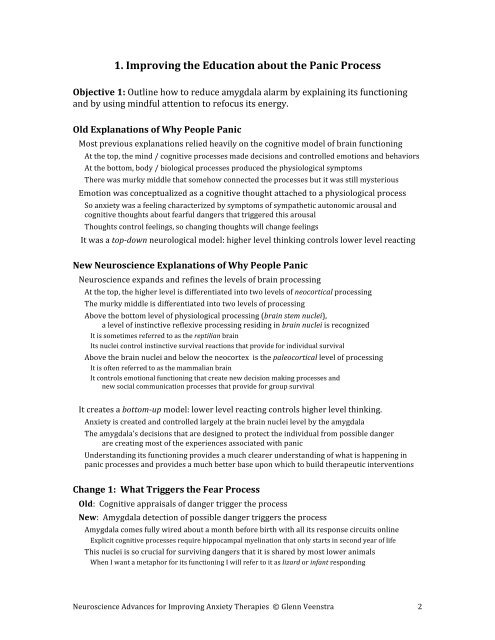Veenstra 170 - Anxiety Disorders Association of America
Veenstra 170 - Anxiety Disorders Association of America
Veenstra 170 - Anxiety Disorders Association of America
You also want an ePaper? Increase the reach of your titles
YUMPU automatically turns print PDFs into web optimized ePapers that Google loves.
1. Improving the Education about the Panic Process<br />
Objective 1: Outline how to reduce amygdala alarm by explaining its functioning<br />
and by using mindful attention to refocus its energy.<br />
Old Explanations <strong>of</strong> Why People Panic<br />
Most previous explanations relied heavily on the cognitive model <strong>of</strong> brain functioning<br />
At the top, the mind / cognitive processes made decisions and controlled emotions and behaviors<br />
At the bottom, body / biological processes produced the physiological symptoms<br />
There was murky middle that somehow connected the processes but it was still mysterious<br />
Emotion was conceptualized as a cognitive thought attached to a physiological process<br />
So anxiety was a feeling characterized by symptoms <strong>of</strong> sympathetic autonomic arousal and<br />
cognitive thoughts about fearful dangers that triggered this arousal<br />
Thoughts control feelings, so changing thoughts will change feelings<br />
It was a top-‐down neurological model: higher level thinking controls lower level reacting<br />
New Neuroscience Explanations <strong>of</strong> Why People Panic<br />
Neuroscience expands and refines the levels <strong>of</strong> brain processing<br />
At the top, the higher level is differentiated into two levels <strong>of</strong> neocortical processing<br />
The murky middle is differentiated into two levels <strong>of</strong> processing<br />
Above the bottom level <strong>of</strong> physiological processing (brain stem nuclei),<br />
a level <strong>of</strong> instinctive reflexive processing residing in brain nuclei is recognized<br />
It is sometimes referred to as the reptilian brain<br />
Its nuclei control instinctive survival reactions that provide for individual survival<br />
Above the brain nuclei and below the neocortex is the paleocortical level <strong>of</strong> processing<br />
It is <strong>of</strong>ten referred to as the mammalian brain<br />
It controls emotional functioning that create new decision making processes and<br />
new social communication processes that provide for group survival<br />
It creates a bottom-‐up model: lower level reacting controls higher level thinking.<br />
<strong>Anxiety</strong> is created and controlled largely at the brain nuclei level by the amygdala<br />
The amygdala’s decisions that are designed to protect the individual from possible danger<br />
are creating most <strong>of</strong> the experiences associated with panic<br />
Understanding its functioning provides a much clearer understanding <strong>of</strong> what is happening in<br />
panic processes and provides a much better base upon which to build therapeutic interventions<br />
Change 1: What Triggers the Fear Process<br />
Old: Cognitive appraisals <strong>of</strong> danger trigger the process<br />
New: Amygdala detection <strong>of</strong> possible danger triggers the process<br />
Amygdala comes fully wired about a month before birth with all its response circuits online<br />
Explicit cognitive processes require hippocampal myelination that only starts in second year <strong>of</strong> life<br />
This nuclei is so crucial for surviving dangers that it is shared by most lower animals<br />
When I want a metaphor for its functioning I will refer to it as lizard or infant responding<br />
Neuroscience Advances for Improving <strong>Anxiety</strong> Therapies © Glenn <strong>Veenstra</strong> 2


